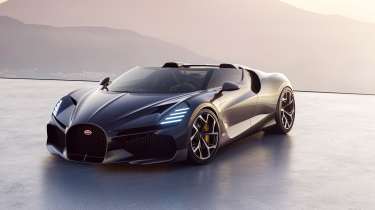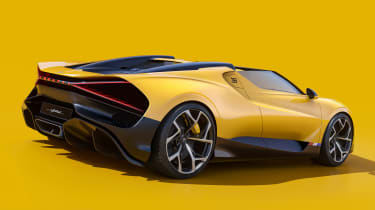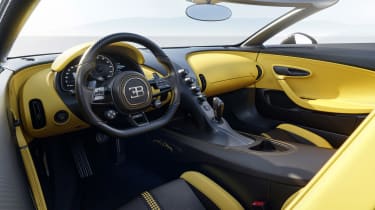Bugatti signs off iconic W16 powertrain with the new Mistral roadster
Bugatti’s headed for an electric future under Mate Rimac, but not before it signs off the W16 with the new Mistral roadster
Few cars portray a leap of faith in engineering such as did the Bugatti Veyron. Born in an era of engineering provenance driven by the late VW CEO Ferdinand Piëch, the rebirth of Bugatti was the Group’s most ambitious high performance project in half a century, one that was fundamentally underpinned by the W16 quad-turbo powertrain that will see its last application nearly 18 years after its introduction in this final model, the Bugatti Mistral.
Like all Bugatti specials, the Mistral’s underlying structure is derived from a single core model, in this case the Chiron. It takes a few tangents, though, in this case being the first and subsequently the only open-top variant based around this second generation architecture. This is combined with the W16’s most potent ever tune, sharing a 1577bhp output with the Chiron Super Sport 300+.
> £7.3m Bugatti Centodieci nears production ahead of 2022 deliveries
The Mistral’s numbers are suitably big, that auspicious peak power figure coming in at 7000rpm. Torque’s rated at 1180lb ft between 2250 and 7000rpm, with the engine’s redline coming 100rpm after – itself 300rpm higher than the standard Chiron. To hit these increased engine speeds, the components of the W16 itself have been redesigned or optimised, from deep in the internals to a new valve and chain drive and lighter, bigger and more efficient turbos.
Bugatti hasn’t confirmed specific performance figures, but this powertrain in this tune was the very one that took the Chiron Super Sport 300+ to its record breaking 304mph top speed run in 2019. It’s a figure that obviously won’t be matched by the Mistral, but it puts into context how potent this giant powertrain is, and how much we’ll miss it – even in an era of 2000bhp EVs.
In order to create the Mistral’s open-top design, Bugatti has created an entirely bespoke carbonfibre monocoque, creating a more rounded silhouette that’s distinctive from the coupe. From here, its design takes a few cues from its one-off La Voiture Noire, but this is no carbon(fibre) copy, as it comes with a less ornate aesthetic. Its proportions are very obviously modern Bugatti, but the key difference is not just its lack of a roof, but the very different shapes created by its near-frameless visor-like windscreen and side glass treatment.
This isn’t the first time that visor-like glass has appeared on a Bugatti, but without a roof in place, its profiling is even more obvious. Beyond the glass, the bodywork itself strikes a balance between the curvaceous forms that we’ve become used to, and a more teutonic quality that might be a look ahead at things to come in Bugatti design. The horseshoe grille typically drives most of the car’s lines, and like the La Voiture Noire has new vertical lighting units that stretch up the front arches – but the shapes are tighter, more defined and yet at the same time also more restrained.
The W16 breathes through two massive intake snorkels that sit independently of the coloured bodywork, with a bridge connecting the two that will house both the third brake light and a vertical rear glass screen. The rear of the car is fairly typical of Bugatti, with the rear aspect almost completely open to allow the masses of heat generated from the W16 a fast exit. The x-shaped rear lighting is new for a Bugatti road car, but was previewed by the Bolide concept. As in a standard Chiron, there’s a hydraulically adjustable rear wing that’s integrated into the rear aspect, but aggressive aero appendages have been kept to a minimum.
The interior is a variation on the Chiron’s, with a pared back design in terms of toys and instead a focus on sheer quality and personalisation. If proof was needed that ultimate luxury is driven by simplicity, rather than a barrage of digital displays, this is proof. It’s a stunning interior, as it always has been, and one that will prove largely immune to dating over time.
A total of 99 units will be produced, priced at £4.25m before local taxes, making it just over £5m a pop here in the UK. Deliveries will commence in 2024. It’s an astounding amount of money, but then this is the final outing for a powertrain that has so aptly portrayed Bugatti’s history, owners would almost certainly feel like they’re buying a piece of history.
We know that Bugatti’s next steps will be under the stewardship of Mate Rimac – an entrepreneur and visionary car maker that has turned his fledgling EV startup into a true OEM powerhouse. Whether it was Bugattis origin, its ambitious rebirth in the ‘90s or later VW-era capitalisation, there’s always been a visionary at its head, and things look to be no different this time around.









